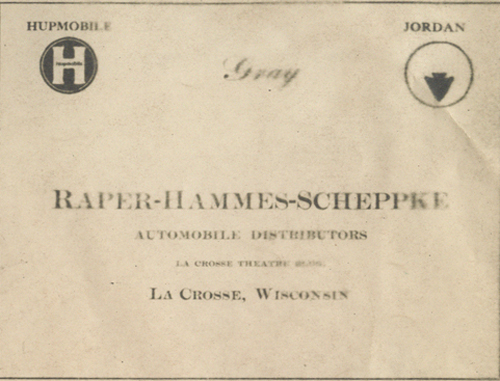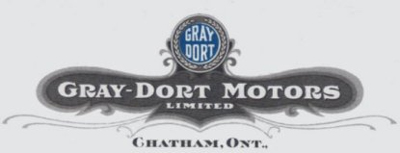![Jerry Hammes.com [Logo]](../../../images/logo.jpg)
|

|
Gray - c.1924
[Back to topic list] [Back to Romy - Business Topic]  Excerpt from speech material prepared by William M. Gray for delivery to the Antique & Classic Car Club of Canada at the Inn On The Park, Toronto on Saturday, September 23, 1967. President James Allward, Head Table Guests, Guests and Members of the Antique & Classic car Club of Canada: "It is both pleasing and a rare experience to be permitted to rise in a gathering, dedicated to preserving the Historical in the automotive field and to receive such a gracious introduction, coupled with the dignity you have conferred on me, as making me an Honorary member of your club." Gray-Dort Memories In 1853, "Wullie Gray", my grandfather, arrived in Chatham on William Street, to open a blacksmith shop of most humble circumstances-there to manufacture Hogs Heads, Bob-sleighs and wagons. His untimely death, made it necessary for my late father - Robert Gray, at the age of 21, to take over the then further-developed factory which was making carriages. The genius of the family, he developed such over the years to a national concept, selling a total of 15,000 buggies, cutters, delivery wagons, motorcar bodies, etc. in the year 1912. All Ford bodies for their Windsor plant were built in Chatham from 1906 to 1912. Following this, however, Ford took the body business to Windsor and at the same time the sale of horse-drawn vehicles was already starting its rapid decline. In the United States, Durant and Dort had made two-wheel Carts, which they sold for $9.00, in carload lots across the Continent. Charlie Nash, later of Nash Motors fame, being the Superintendent and the late Jack Mansfield - later Sales Manager for Dort, and then eventually of Chrysler of Canada - was the Sales Manager. They called him "Carload Jack." Already, Tudhope of Orillia had made connections with Barney Everitt, formerly a trimmer in our carriage plant here in Chatham, who had moved to the States to build automobile bodies. And later, with Metzger & Flanders, formed the E.M.F. Motor Car Company; eventually selling out to Studebaker. With the result that Everitt again started to build his own car, under his own name, which - affiliated with Tudhope in Canada - became known as the Tudhope Everitt. Meanwhile Sam McLaughlin, whose vehicle business was likewise national, was well established by that time with Buick in the States, being known in Canada as the McLaughlin-Buick. Thus, after careful investigation of certain of the vehicle manufacturers we knew in the States, we bypassed Patterson of Flint with his Patterson car and Gardner of St. Louis with his Moon car and chose the Dort because of the splendid reputation that its builder, Josiah Dallas Dort had among the trade. For, already by that time, he had been making the Dort car for 2 years, and it seemed the most logical connection and most convenient. And so the Wm. Gray & Sons Campbell Co. of Chatham incorporated as a subsidiary "Gray-Dort Motors Ltd."; and gave to the Dort Motor Car Company, a 30% share of the stock for the privilege of the use of their dies, their engineering and their various purchasing sources and contracts of supply. Our intent, over the longer term, was to set about to achieve a high level of Canadian content and production. The Gray-Dort is a story of ever-climbing spirals of achievement, as from a modest beginning of 25 cars - mostly the parts being imported in the Fall of 1915, to an output of 7000 cars in the year 1921, Gray-Dort captured a goodly share of the Canadian market with its already established factory sales branches in the vehicle industry, being rapidly converted to the automotive field. For branches had already been operating in Montreal, Ottawa, Toronto, Hamilton, London, Winnipeg, Moose Jaw, Calgary, Edmonton and Vancouver. Thus, there was, at once, an immediate outlet of nearly 400 dealers under all these branches. Not the least of Gray-Dort achievements was the impetus provided to Canadian parts manufacturers. For by 1921, over 60% of the car was Canadian made. Bodies were made in a former carriage plant with some stampings from Canada, but most from the States. Our own sheet metal plant produced the fenders, hoods, etc. Dash cowls of mahogany came from Woodstock while lamps, front axles, windshields, frames and Cushion springs came from their respective sources in Windsor. A special Canadian and much improved rear axle, developed by Hayes was made in Chatham and differed from the one used in the American car. Transmissions and radiators came from St. Catherines, Malleables from Galt. But why go on, for the only interesting outcome is that most of these suppliers carried on long after Gray-Dort had folded and are established, even at present, in their own field. Statistics, at best, are dry. And, in this instance, seem puny compared to present Giants of the industry. But I mention them only, knowing that your vintage perspective is such as to place them in a suitable ratio of recognition. Between 1916 and 1923, about 23,000 Gray-Dort cars were turned out in the Chatham plants. In the beginning, of course, they were all 4-cylinder cars with Lycoming, 2-bearing, crankshaft motors. But, in the latter years, they were augmented by the Falls 6-cylinder motor. The highest peak of employees was 825 and, if you were to include all the dependents on the sales division, service and their families as across Canada with their branches, you'll reach a total of 3,400 persons. The 3 plants in Chatham exceeded an investment of over $1,300,000; and had a total floor space of 430,000 square feet-the 3 combined, covering 15 1/2 acres of ground. Of which now, no trace of any kind remains. There isn't much more to tell, except one day, Mr. Dort came over to the office of my father, and extremely disturbed, said: "Bob, I'm through. This thing has got too big for me. I'm going to pay off my creditors and get out." You see, by that time, we were turning out 7000 jobs a year, for a population of 10 million people in Canada, while Dort was only turning out 80,000 jobs in the States, for a population of 120 million so that he was unable to spread his engineering and die costs thin enough to meet competition. The sad result-well, in 30 days when the news got out about Dort quitting in the States--we couldn't give our cars away. For everyone said: "Where would we get parts?" And so from a substantial cash balance in the bank, so difficult was it to get out from under factory and branch commitments and obligations, that within a few months, we ended up owing the bank $1,200,000. In the meantime, frantically, I had made a hook-up with the Gray Motor Car Company of Detroit - a late-comer to the field, with a car very similar to the Model T; and headed by Mr. Klingermsmith, formerly Vice-President of Ford; and Mr. Beall, a Packard engineer. Both of these men had teamed up with the Gray Marine Motors of Detroit. But before we could get going, they also bit the dust. Fortunately, having extra mill capacity, I had formed - awhile previously - a separate entity "The Motor & Coach", a wholly owned subsidiary of Gray-Dort. They, in turn, built Overland, Durant and Dodge millwork and, in some instances, some Dodge bodies. On stepping out of Gray-Dort with my father in March of 1924, it eventually fell to my late brother-in-law - Mr. William Goodeve - to continue the Motor & Coach operation of the Company, and to liquidate such receivables as would bring in returns. But with the eventual switching of the entire industry to metal bodies, Motor & Coach found its services of no further value to the trade. But they had succeeded in clearing our indebtedness down to the small sum of $200,000, which the bank finally wrote off. Today, none of the three Gray-Dort plants are left standing. Although a former local sales room still bears the name and is often mistaken for a production plant. Story submitted by Ronald Gray - William Gray's son      |
 |
 |
 |
 |
 |
 |
 |
 |